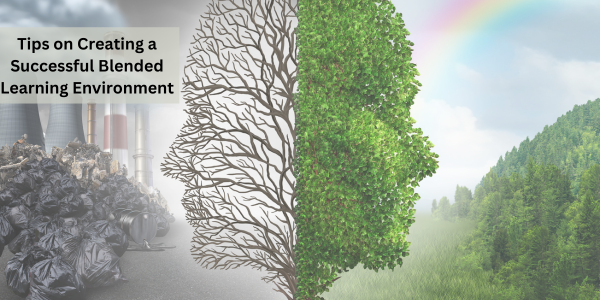 Blended learning is an approach for education that combines traditional classroom instruction with online or digital learning. Creating a successful blended learning environment requires careful planning and execution. In this blog, we will explore the key elements of a successful blended learning environment, including technology tools, instructional design, and teacher support. By following the below-mentioned guidelines, educators can create a blended learning experience that maximizes student learning outcomes and engagement.
Blended learning is an approach for education that combines traditional classroom instruction with online or digital learning. Creating a successful blended learning environment requires careful planning and execution. In this blog, we will explore the key elements of a successful blended learning environment, including technology tools, instructional design, and teacher support. By following the below-mentioned guidelines, educators can create a blended learning experience that maximizes student learning outcomes and engagement.
How to create a successful blended learning environment?
Blended learning has become an increasingly popular approach in education, that offers a flexible and effective way for educators to combine online and in-person learning experiences. Here are some steps to follow to create a successful blended learning environment:
- Determine the learning objectives and outcomes: Before beginning any blended learning program, it is important to clearly define the learning objectives and outcomes for students. This will guide the selection of appropriate technology tools and instructional strategies.
- Choose appropriate technology tools: Technology is at the heart of blended learning, so it is essential to select the right tools that align with the learning objectives and outcomes. This can include a learning management system (LMS), video conferencing tools, educational apps, and other digital resources.
- Create a consistent structure: To help students stay organized and focused, it is important to establish a consistent structure for the blended learning program. This can include regular schedules, clear instructions, and accessible resources.
- Use a variety of instructional strategies: Blended learning provides an opportunity to combine different instructional strategies to meet the needs of diverse learners. This can include online lectures, collaborative group work, hands-on projects, and other interactive activities.
- Provide ongoing teacher support: Blended learning can be a new and challenging experience for educators, so it is important to provide ongoing support to ensure success. This can include professional development opportunities, coaching, and access to technical support.
By following these steps, educators can create a successful blended learning environment that enhances student learning outcomes and engagement.
Also Read: 6 Tips on How to Improve Your Communication Skills
Advantages of a successful blended learning environment
A successful blended learning environment can offer several advantages for both educators and students. Here are some of the key advantages:
- Flexibility: Blended learning offers flexibility in terms of time and location, allowing students to learn at their own pace and on their own schedule. This can be particularly beneficial for adult learners or students with other commitments, such as work or family obligations.
- Personalization: Blended learning can provide a personalized learning experience, allowing students to work at their own level and pace. This can help students who struggle with certain topics to get extra support while also allowing high-achieving students to move ahead at their own pace.
- Engagement: Blended learning can help increase student engagement by offering a variety of instructional strategies and opportunities for interaction. This can include online discussions, group work, and other collaborative activities.
- Cost-effective: Blended learning can be a cost-effective way to deliver education, as it reduces the need for physical space and resources. This can be particularly beneficial for schools with limited budgets or for delivering education to students in remote areas.
- Performance tracking: Blended learning can provide valuable data and insights into student performance, allowing educators to identify areas of strength and weakness and adjust instructional strategies accordingly.
Overall, a successful blended learning environment can offer many benefits, including flexibility, personalization, engagement, cost-effectiveness, and performance tracking.
Also Read: The Role of Mock Interviews in Interview Preparation
Disadvantages of a successful blended learning environment
While blended learning can offer many benefits, there are also some potential disadvantages to consider. Here are some of the main disadvantages of a successful blended learning environment:
- Dependence on technology: Blended learning relies heavily on technology, and any issues with connectivity or hardware can disrupt the learning experience. This can be particularly challenging for students who may not have access to reliable technology or internet connections.
- Lack of face-to-face interaction: While blended learning can offer some opportunities for in-person interaction, it may not provide the same level of socialization and community building as a traditional classroom setting. This can be especially problematic for students who thrive on social interaction.
- Need for self-motivation: Blended learning requires students to be self-motivated and disciplined, as they may be responsible for managing their own learning schedule and progress. This can be challenging for students who struggle with self-discipline or who may need more guidance and support.
- Potential for isolation: Blended learning can lead to feelings of isolation, as students may be working alone for extended periods of time. This can be particularly challenging for students who may already struggle with social anxiety or who have limited opportunities for social interaction outside of school.
- Teacher workload: Blended learning can be more demanding on teachers, as they may need to create and manage online content in addition to their regular teaching duties. This can be particularly challenging for teachers who may not have adequate support or training in technology and instructional design.
Overall, while blended learning can offer many advantages, it is important to be aware of the potential disadvantages and take steps to mitigate them. This can include providing adequate technology and support, promoting social interaction, and ensuring that students have the necessary self-discipline and motivation to succeed in a blended learning environment.
Blended learning can be a powerful tool for enhancing student learning outcomes and engagement, but it requires careful planning, execution, and ongoing support to be successful. By following the steps outlined in this blog, educators can create a blended learning environment that meets the diverse needs of their students and maximizes the potential of technology and online resources. By embracing the flexibility and personalization offered by blended learning, educators can create a more engaging and effective learning experience for their students, while also providing opportunities for cost-effective and data-driven instruction. With the right approach and support, blended learning can transform education and help prepare students for success in a rapidly evolving digital world.
Also Read: Select the Best Resume Format Among Chronological, Functional, or Combination
FAQs
Q1: What is blended learning?
Ans: Blended learning is an approach that combines traditional face-to-face instruction with online learning experiences.
Q2: What are the benefits of blended learning?
Ans. Blended learning can offer flexibility, personalization, increased engagement, and improved outcomes for students.
Q3: What challenges may arise in a blended learning environment?
Ans: Challenges that may arise in a blended learning environment include technological issues, lack of student motivation, difficulty in managing the online and offline components, and the need to adjust to a new teaching approach.

























